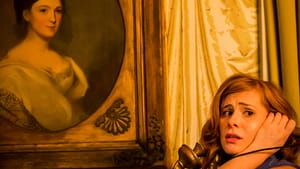Stay in the Loop
BSR publishes on a weekly schedule, with an email newsletter every Wednesday and Thursday morning. There’s no paywall, and subscribing is always free.
Is a 1920s shocker worth mounting today?
Fringe 2015: 'The Captive' by Philadelphia Artists' Collective (second review)

After watching Philadelphia Artists’ Collective’s The Captive, I’m curious about the line between classical and contemporary theater. The company’s stated mission is “rare classical theatre,” but apparently a play that premiered in France and New York in 1926 counts as a classic. So what’s the definition of a classic? Something at least ninety years old? Or something with great cultural import, no matter what the era?
Director Dan Hodge stages Édouard Bourdet’s The Captive (or, as I might title it, Men Who Enjoy Their Own Peccadillos Force Women into Chairs to Interrogate Them about Their Sex Lives) effectively in the lush and intimate historical setting of Society Hill’s Physick House — never mind that the house was actually built in the late 1700s: It’s pretty, it’s historic, and We Are Not In 2015.
‘A rather odd life’
As Steve Cohen notes in his review, the play was so desperately controversial at its 1926 New York premiere that stars Basil Rathbone and Helen Menken were escorted to jail after their curtain call (they were released quickly as producers promised to close the show, to Rathbone’s great chagrin at such censorship). The play’s pivotal revelation about its female protagonist, Irene, a diplomat’s 25-year-old daughter in Paris, who’s living “a rather odd life for a young unmarried girl,” may have shocked audiences of the ‘20s, but from the opening lines of a 2015 production, it’s not hard to guess.
Take a gander at J. Brooks Atkinson’s New York Times review from September 30, 1926, in which he calls the play “expertly written and admirably played,” albeit “horrible in its implications.”
The Captive (La Prisonnière in its original French), Atkinson writes, is about “the tragedy” of a nice young lady “who falls into a twisted relationship with another woman.” The critic hopes that this “loathsome possibility” won’t deter audiences from a fine production, as Irene’s lesbian lover, never seen onstage, “hangs over the drama like a black pall, a prescience of impending doom.”
Jesus.
The show is running as part of the Philly Fringe through September 20, so I won’t dig into the details of the plot, besides saying that Hodge’s direction, in the greater tolerance of 21st-century mores, leaves the ending of the play and the characters’ fate much more open to your interpretation. This contrasts with the certain doom Atkinson assumed: “The sound of a closing door offstage completes this sombre story.”
Promises, jealousy, love compelled
Take away the shock and awe of a drawing-room melodrama dealing with homosexuality in the 1920s, and what do we have now? A lot of florid shouting about love and perceptions of love that is unlikely to surprise anyone: You can’t believe a woman who promises to love you forever, but you also can’t believe her if she promises not to. If you’re not in love with someone (at least by early 20th-century standards of a proper monogamous marriage), it’s pretty damn hard to feel jealous of what he does. And you can’t love somebody just because he really, really wishes you did.
The presence of Alex Boyle as Irene’s (Rachel Brodeur) naïve yet courageous little sister, Gisele, reminds me of Boyle’s recent luminous turn in the Lantern’s Arcadia, and the intellectual fireworks that are lacking from soap operas like The Captive (of any era or medium) that are essentially about who’s having sex with whom and why.
Yes, the human heart is always rich with worthy themes, as Hodge notes in the playbill: “At its core, the play is about people starved for love and understanding who cannot find a common ground for communication.” Maybe he does have a touch of Atkinson’s pessimism about the whole thing: “It is an ugly reminder that you can never know the heart of the person seated next to you.”
Fine new staging of an old story
Even if it doesn’t shed any light on the human condition that will have you ruminating in the morning, the play’s characters and story will grab you from the opening scene. This is due in large part to Hodge’s sharp and detailed direction and an assured and earnest cast. The urge to stage this play in the rooms of a historic house, the audience crowded on a few rows of chairs right in front of the actors, perfectly bolsters a naughty and compelling sense of eavesdropping on the characters.
The only quibble I have with the show’s direction is that in such an intimate space, some opportunities for nuance that might otherwise be impossible onstage are lost as the actors’ voices thunder repeatedly through the small room. Some moments could have been more effective if played more quietly.
But working with minimal props and set, Hodge and the ensemble (including Chase Byrd, Joel Guerrero, Felicia Leicht, John Lopes, Ben Mahan, and Michelle Pauls) make sensitive and successful use of the space through choices as simple and deliberate as opening and closing the doors. In such close quarters, it’s a tactile as well as a visual shift, when the burgeoning heat of closed doors contrasts with transitional wafts of cool air as characters come and go, resetting the scene in more ways than one.
Excellent period props like pens and telephones from Jeanette Leh add authenticity, but I wonder if budget constraints hampered costume designer Robin I. Shane, who has wealthy and stylish characters appearing in the same outfits in acts that span a month and a year’s time.
For a festival that’s practically defined by the unpredictability of its shows, The Captive, because of its cast, setting, and direction, is a fine production and a reliable ticket — as long as 100 minutes of paternalistic hand-wringing over women’s sex lives is what grabs you. And judging by the cover of every other magazine on the planet, it’s not a topic we’ve lost any interest in since the 1920s.
What, When, Where
The Captive. By Édouard Bourdet, translation by Arthur Hornblow. Dan Hodge directed. Philadelphia Artists’ Collective, through September 20 as part of the 2015 Philadelphia Fringe Festival. The Physick House, 321 South 4th Street, Philadelphia. 215-413-1318 or philartistscollective.org; fringearts.com/event/the-captive/.
Sign up for our newsletter
All of the week's new articles, all in one place. Sign up for the free weekly BSR newsletters, and don't miss a conversation.

 Alaina Johns
Alaina Johns